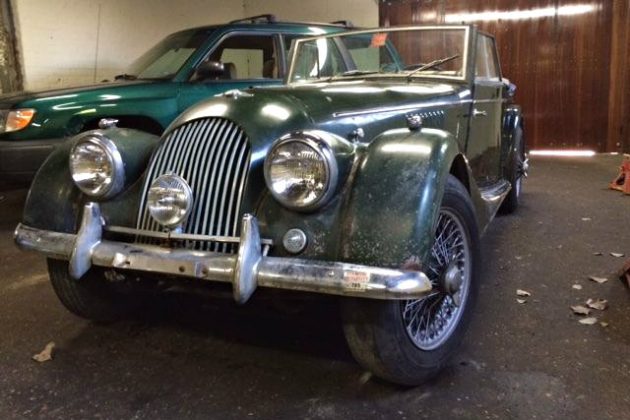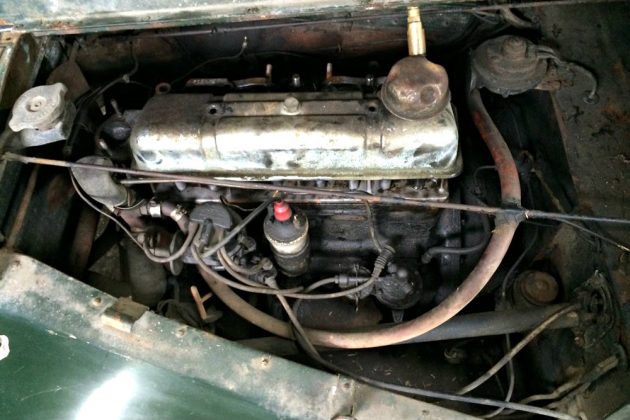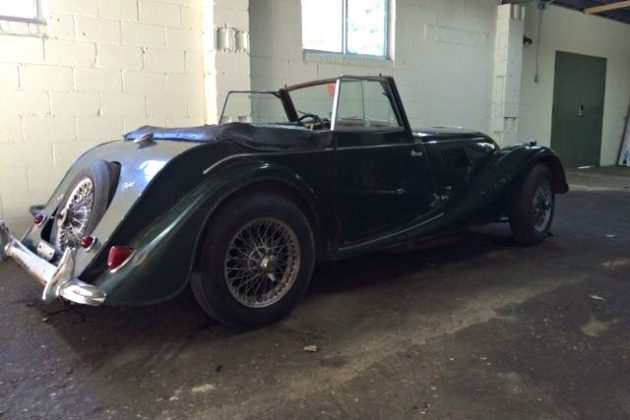Morgans are such interesting vehicles being primarily constructed with wood, and finding an original condition car that is solid is truly a rarity. Originally sold in Holland in 1963, this Morgan made it to New York state where it was then parked in 1968 due to a potential valve issue. Completely original and 99% complete, this very solid surviving Morgan looks like all it really needs is a mechanical restoration. With a couple of days remaining, bidding has risen to $10,200 with the reserve not met. Check out this British classic here on ebay out of Petersburg, Virginia. Thanks to reader Peter Rettig for the great submission!
The small and simple TR4 engine may very well be why this Morgan is in such good condition. In 1968 a valve issue occurred where the car was parked. At some point between then and the current owner the cylinder head has been pulled as well as the carbs. I assume the head to be resting on top of the block, but unfortunately there are no photos of the cylinder walls, or any further details on the engine. One very important fact that is mentioned is that this engine number corresponds to the chassis number.
Although a little dirty, the interior of this Morgan is original and has a charming patina that could certainly be worked with. The leather seats could likely be conditioned, and made useful maintaining this cars originality. The steering wheel is in excellent condition with no obvious wear or cracking. Even the carpeting is original, but dingy, needing a careful cleaning and re-installation. The wood dash looks a little dirty, maybe even a slightly moldy, but would likely clean up nicely and present wonderfully with some careful treatment of the wood.
Although having a few minor blemishes, this Morgan is pleasantly original and very much in driver condition. The only real concerns about this car seem manageable. As far as rust goes this Morgan is very rust free with the only rust of any consequence having developed on the tip of the rear fenders, which is not surprising. Then comes the ash frame and its wood components. The only concern about the wood is the inner strips above the door sills. Although the seller doesn’t out right say there is rot there, he does allude to there being some concern and that the sills could either be fabricated, or purchased from Morgan. Beyond these areas this Morgan appears remarkably solid and original making it a very worthy project, and perhaps even a worthwhile preservation effort depending on your taste. Would you restore, or preserve this fine example of a Morgan?





Dibs!
Seriously, though, a Morgan has always been on my short list of must-haves-at-least-once-in-my-life. Someone talk me out of it.
This listing says some odd things.
– It’s a Plus 4, not Plus Four.
– The miles are said to be 9,500 in one place in the listing but 42,000 in another place.
– The car does not look like it has only 9,500 miles.
– The car is said to be “simple and completely within the capabilites of the do it yourselfer mechanic”, but replacing the wood body frame and the metal panels aren’t.
– Seller says “Disk brakes all around”, but the rears are drums.
– Two Morgans shown in the listing, one green with lots of needs, one blue and looking pretty nice. Seller has sown confusion, perhaps intentionally and definitey confusing, and has tried to disentangle himself.
I think with this seller you are on your own.
I really like the look of these vintage Morgans. It’s hard to think of a classier sportscar with such a vintage look.
But as much as I like the look, the vintage nature of the beast has kept me from being an owner. The whippy chassis, the ancient suspension, the hard, not-very-compliant ride, the fact that I had to take off my right shoe to get my foot onto the accelerator pedal because of tight space in the Plus 8 I test drove—-add them up and it’s a car that I would love to look at in my garage, but that I couldn’t really enjoy driving.
I’ve seen a nicely prepped, not heavily modified Morgan place consistently in the top 20 in autocross. And this is in SoCal. Not weak competition. I’ve seen other Morgans place mid pack over and over again. For what they are, the chassis , brakes, and suspension are awesome!
The Wooden frame myth persists, it does not have a wooden frame. There are wood panels that the metal bodywork is attached to. Not unlike an early Chevrolet. I had a doctor friend in Portland that bought a new one every few years, most had Triumph drive trains. He would drive to the race track on race days, tape the headlights and out run every Triumph on the track……so, I think there is something about the ancient suspension that works.
Dave, PIR is waaaayyy smother than a lot of the potholed, poorly maintained roads in No America. In everyday life a Morgan is not a car that I would want to drive much on roads like that.
And if you are referring to my comment about the ‘wood body frame’ on these cars (not “Wooden frame”), these Morgans actually do have a body frame made of wood onto which metal body panels are nailed.
Here is a photo, the caption of which reads: “Ash body frames, stacked and awaiting assembly. Morgan still utilizes ash wood for its body frames.”
My point was that replacing all or part of that frame is not “simple and completely within the capabilites of the do it yourselfer mechanic” that the seller claimed.
Source: “A mid-Seventies tour of the Morgan Motor Company factory”, Hemmings Daily, May 19th, 2014.
Sort of like this……….Chevrolet coupe
Seller obviously doesn’t know the difference a head and a sump
There’s an episode of Wheeler Dealers that shows what it’s take to replace the body framework. A quick search will turn up several videos. It’s not impossible, but it looks like a lot of work. Season 9, episode 2
It was very good too. A must see if you are curious and don’t know what’s up with these.
Is this eligible for coverage by Terminix?
In Hawaii, in 1960 we rented a house from Peter Revson ( later to become a famous racer), and he had just gotten a BRG Plus Four. What a beauty! He raced it at Kuhuku Point, Oahu.
Peter Revson – now there’s a name from the annals of racing. It was such a shame that we lost both Peter Revson and Mark Donohue, a year apart, in Formula One accidents. They were team mates at Penske Racing during the early 1970s driving AMC Javelins and winning big. Great period of racing history.
Peter was heir to the Revlon fortune and could have afforded any car he wanted; so, for him to have a Morgan Plus 4 is significant.
Who was the car mag wag in the late ’60s who, in a road test article, referred to a then current Plus Four as “…the only automobile currently in production that is susceptible to Dutch Elm disease…”?
Probably Henry Manney III
Very probably…
There was also a car mag wag that absolutely LOVED his “Moggies”. Dennis Siminaitis (sp), if memory serves. Quite a large man too, yet he squeezed himself in and went on all sorts of events in his. I believe he went into the finer points of the wooden framework on more than one occasion. He wrote for either R&T or Car and Driver.
“Primarily constructed with wood” remains a fairly ignorant statement in the original write-up. Not like there’s a mahogany block in there. Some early Marcos models had a lot more wood. “Construction little changed since the 1930s” would be closer to the mark.
Interesting that it is a drop head. With oil pan sitting on the cowl, hard to say what’s really up with the engine. The shot of the front end appears a bit rusty, so have to wonder how the crosshead and other still chassis parts really are for rust. At least lots of mechanical parts are easy to source for Mogs. There’s a great book on living with and maintaining Morgans written by Fred Sissons. Our 63 +4 is about 140 cars earlier than this one. This could be a relatively easy one to get to driver status or prove to be a steep, slippery slope to a major refresh…
There is a ’35 or ’36 Chevy Standard sitting in a front yard a few miles from me. I stopped and looked at it a few times, it is now protected by bee hives and a “no trespassing” sign. Clearly it has wood rot, the doors hang funny, for example. It is amazing how simple a machine it is. And maybe it is a ’35 since I seem to remember that by ’36 Chevy went to an all steel body.
As others have pointed out, the frame is steel. The body panels are steel. And the steel body panels are arrayed to a wood superstructure.
I’ve owned three Morgans over the years. This car is a Drophead Coupe, making it more rare and desirable than the more common roadster. There are several places on these cars that harbor rust, particularly where wood and metal come together. Morgan did very little to prevent rust when this car was built. I would advise anyone considering the purchase of this car to do an in person inspection. The stiff suspension used on these cars often results in cracks in the frame and other stressed components. Fun car to drive, as long as you don’t mind having the fillings shaken loose from your teeth!